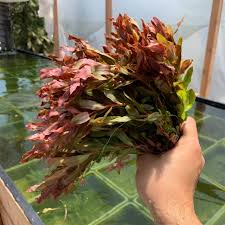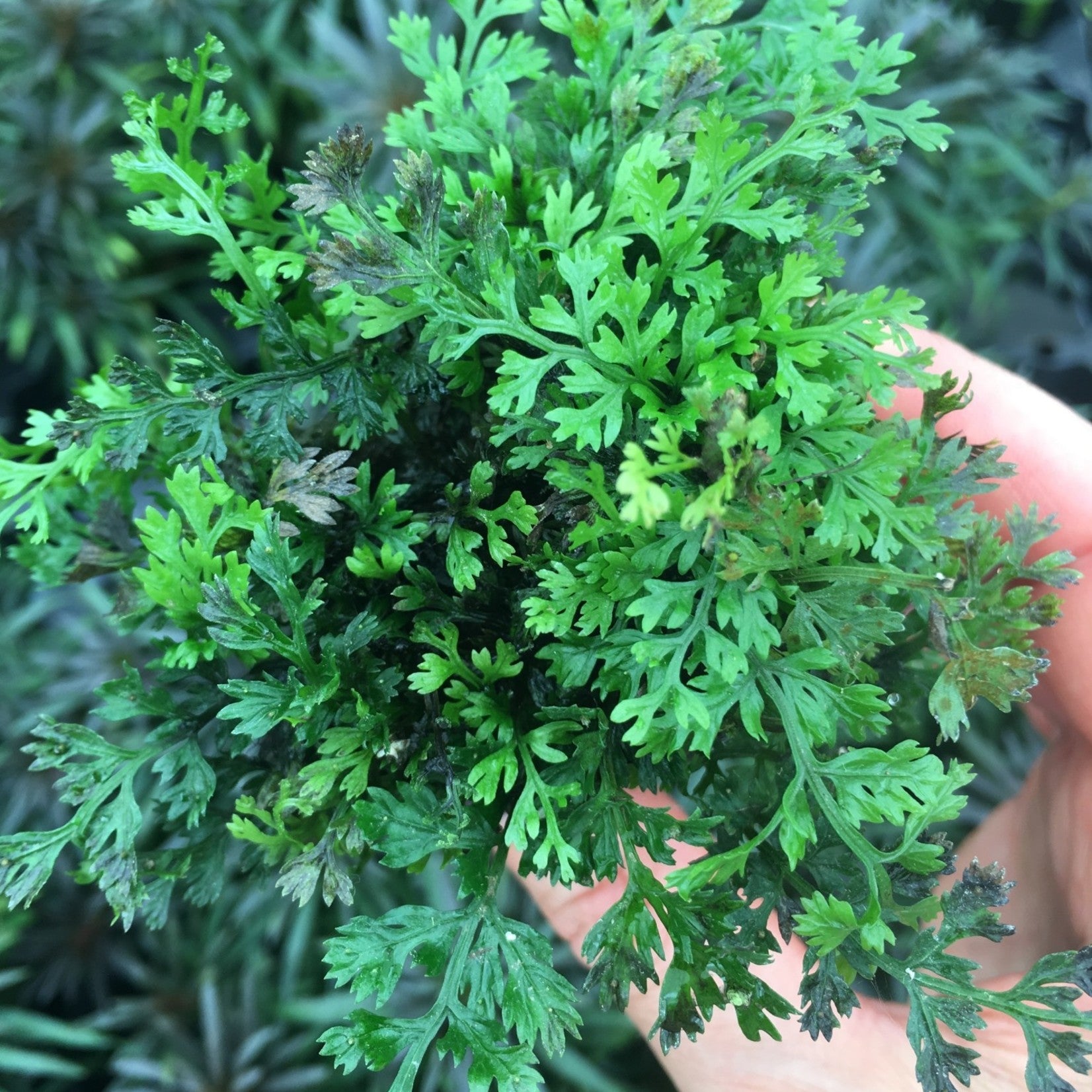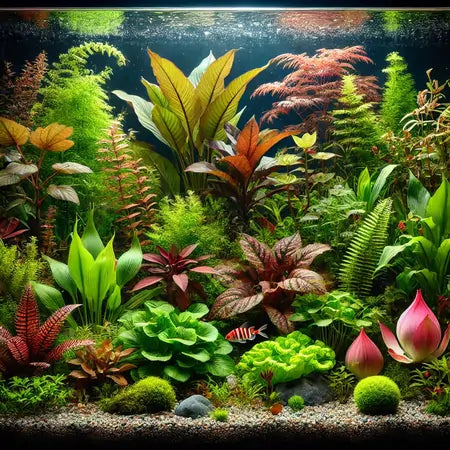Trending searches
$0

I. Introduction
Cryptocoryne plants, commonly known as "Crypts," are a diverse group of aquatic plants highly valued in the aquarium hobby for their aesthetic appeal and relatively low maintenance requirements. Belonging to the Araceae family, these plants are renowned for their adaptability and variety, with over 60 recognized species.
Cryptocoryne species are distinguished by their wide range of leaf shapes, sizes, and colors, which can vary significantly even within a single species. They are primarily rosette plants, growing from a central point and spreading outwards. The leaves can be lanceolate, ovate, or even ribbon-like, and they often exhibit interesting textures and hues, from green and brown to red and purple. One of the unique characteristics of Cryptocoryne plants is their ability to undergo crypt-specific changes in leaf morphology based on environmental conditions, a phenomenon known as crypt polymorphism.
II. Common Varieties of Cryptocoryne
1. Cryptocoryne wendtii
 Product link: cryptocoryne_wendtii.canton_aquatics
Product link: cryptocoryne_wendtii.canton_aquatics
Cryptocoryne wendtii is one of the most popular and widely available species. It comes in various color forms, including green, brown, and red. The leaves are typically lanceolate and can range from smooth to ruffled edges.
2. Cryptocoryne undulata

Cryptocoryne undulata features elongated, wavy-edged leaves that can vary in color from green to reddish-brown. The plant tends to grow more upright compared to some other Cryptocoryne species.
3. Cryptocoryne parva

Product link: cryptocoryne_parva.canton_aquatics
Cryptocoryne parva is one of the smallest species, making it ideal for foreground planting. It has small, bright green leaves that grow in a rosette pattern.
4. Cryptocoryne balansae

Cryptocoryne balansae is known for its long, crinkled, strap-like leaves that can add a unique texture to the aquarium. The leaves can grow very long, making it suitable for background planting.
5. Cryptocoryne Crypt Lutea

Product link: cryptocoryne_lutea.canton_aquatics
Cryptocoryne lutea has medium-sized, lance-shaped leaves that can vary in color from green to brown. It is a robust species that can adapt to various conditions.
6. Cryptocoryne Crypt Lucens

Cryptocoryne lucens is a smaller species with narrow, elongated leaves that are light green in color. It forms dense clumps, making it suitable for foreground and mid.
Cryptocoryne plants are not only popular for their aesthetic appeal but also for the numerous benefits they bring to aquarium ecosystems.
They support beneficial bacteria that convert harmful ammonia and nitrite into less toxic nitrate and absorb excess nutrients, improving water quality and preventing algae blooms.
Through photosynthesis, they contribute to oxygen levels in the water, essential for the health of fish and microorganisms.
With their diverse leaf colors and shapes, Cryptocorynes enhance the visual appeal of aquariums, creating a natural and realistic underwater landscape.
They offer hiding spots and breeding grounds for fish, reducing stress and encouraging natural behaviors, which helps recreate a natural habitat.
IV. Combining Cryptocoryne with Other Aquatic Plants
Incorporating Cryptocoryne plants with other aquatic plants can create a dynamic and visually appealing aquarium
Pair Cryptocorynes with plants that have different leaf shapes, like Anubias or Java Fern, to add visual interest.
Use shorter Cryptocorynes like C. parva in the foreground, medium-sized ones like C. lucens in the midground, and taller species like C. balansae in the background for depth.
Mix Cryptocorynes with plants of different colors and textures, such as Dwarf Hairgrass or Alternanthera reineckii, to enhance visual appeal.
Choose plants with similar light and substrate needs, such as Java Fern, Anubias, and Vallisneria, to ensure compatibility.
Plan your layout to provide enough space for each plant to grow, preventing competition for nutrients and light.
These strategies will help create a harmonious and thriving aquarium with Cryptocoryne plants and other aquatic flora.
V. Caring for Cryptocoryne in Aquarium
1. Cryptocoryne wendtii
Special Note: It is very adaptable and often the go-to species for beginners.
2. Cryptocoryne undulata
- Light: Low to moderate.
- Substrate: Rich in nutrients.
- Water: Temperature 22-28°C, pH 6.0-7.5.
- CO2: Enhances growth but not essential.
Special Note: Known for its tolerance to varying water conditions.
3. Cryptocoryne parva
- Light: Moderate to high.
- Substrate: Nutrient-rich substrate essential.
- Water: Temperature 22-28°C, pH 6.0-7.5.
- CO2: Highly beneficial for optimal growth.
Special Note: Slow-growing and requires patience but provides a beautiful carpet effect.
4. Cryptocoryne balansae
- Light: Low to moderate.
- Substrate: Rich in nutrients, deep enough to accommodate long roots.
- Water: Temperature 22-28°C, pH 6.0-7.5.
- CO2: Beneficial.
Special Note: Provides excellent hiding spots for fish due to its dense growth.
5. Cryptocoryne lutea (Cryptocoryne Crypt Lutea)
- Light: Low to moderate.
- Substrate: Nutrient-rich preferred.
- Water: Temperature 22-28°C, pH 6.0-7.5.
- CO2: Enhances growth but not mandatory.
Special Note: Often used in midground planting due to its moderate height.
6. Cryptocoryne lucens (Cryptocoryne Crypt Lucens)
- Light: Low to moderate.
- Substrate: Nutrient-rich substrate preferred.
- Water: Temperature 22-28°C, pH 6.0-7.5.
- CO2: Beneficial for better growth.
Special Note: It’s relatively easy to care for and adapts well to a variety of aquarium conditions, making it suitable for beginners.
VI. Troubleshooting Common Issues of Cryptocoryne
Cryptocoryne plants are generally hardy, but they can experience some common issues. Here are solutions to address them:
Cause: Nutrient deficiencies, particularly nitrogen, potassium, or iron.
Solution: Use a comprehensive aquarium fertilizer that includes macro and micronutrients. Check and adjust substrate quality, ensuring it is nutrient-rich.
Cause: Sudden changes in water parameters, lighting, or substrate can cause Cryptocoryne melt, where the leaves disintegrate.
Solution: Maintain stable water conditions and avoid drastic changes. If melting occurs, remove decayed leaves, and the plant will usually regrow from the roots.
Cause: Excessive light, high nutrient levels, or imbalanced water conditions.
Solution: Reduce lighting intensity or duration, and ensure you’re not over-fertilizing. Increase water changes and consider adding algae-eating fish or shrimp.
Cause: Insufficient light, poor substrate, lack of nutrients, or inadequate CO2 levels.
Solution: Ensure the plant receives appropriate light levels (usually low to moderate for Cryptocorynes). Use a nutrient-rich substrate or add root tabs. Consider CO2 supplementation if other conditions are optimal.
By addressing these issues promptly, you can ensure healthy and vibrant growth of your Cryptocoryne plants.
Q: What fish are compatible with Cryptocoryne?
A: Compatible fish include tetras, guppies, mollies, platies, Corydoras catfish, and small loaches. Avoid large, aggressive fish like cichlids.
Q: Can Cryptocoryne survive in low-light conditions?
A: Yes, Cryptocoryne plants thrive in low-light conditions, though their growth may be slower.
Q: How often should Cryptocoryne be fertilized?
A: Fertilize with root tabs every few months and use a liquid fertilizer weekly or bi-weekly.
Q: What are the signs of Cryptocoryne deficiency?
A: Signs of Cryptocoryne deficiency include yellowing leaves, which indicate a nitrogen or iron deficiency; holes in leaves, which suggest a potassium deficiency; stunted growth, which points to a general nutrient deficiency; and melting leaves, which can result from sudden changes in conditions or a severe nutrient deficiency.
Cryptocoryne plants are a versatile and beneficial addition to any aquarium. They contribute to biological filtration and oxygenation, enhance the aesthetic appeal with their diverse shapes and colors, and help create a natural habitat for aquatic life. Despite occasional issues such as yellowing leaves, melting, algae growth, and inadequate growth, these can be addressed with proper care and maintenance. Combining Cryptocoryne with other aquatic plants can further enrich the aquarium environment. By understanding and managing their needs, aquarists can enjoy the beauty and benefits of these resilient plants.



Check out our shop for a variety of fresh, farm-grown plants! Find the perfect options to enhance your aquarium today.
!